The below information comes courtesy of the excellent website http://www.ozatwar.com by Peter Dunn, and was provided by Noel Brettoner who spent countless hours researching the history of the airfield and Captain McIntyre. Our sincere thanks go out to both people for permission to reproduce that information here.
"McIntyre Field" was established by the USAAF on the NSW/Victoria border, near the Newell Highway. It originally covered an area of about 25 miles square. The RAAF took over the operation of the airfield in 1942 and named it Tocumwal.
The sign at the main entrance to Tocumwal airfield shows the following units were based there at that time:-
- Station Headquarters
- 82 Wing
- No. 7 Operational Training Unit
- No. 7 Aircraft Depot
- No. 7 Central Recovery Depot
Up to 4,500 RAAF personnel, and 400 WAAAF personnel were based at Tocumwal.Tocumwal was home to up to 54 Liberators, 11 Vultee Vengeance, 5 Kittyhawks and an Airspeed Oxford.
It was also a vast storage and repair depot with aircraft such as Avro Anson, Airacobra, Beaufort, Boeing, Boomerang, Dakota, Hudson, Lancaster, Lincoln, Meteor, Mosquito, Mustang, Spitfire, Beaufighter, Vampire, Winjeel and Wirraway.After the RAAF left Tocumwal in 1960, over 700 aircraft were scrapped through until 1963.Six 39.6 metre timber long span truss roof aircraft hangars. These were the first long span trusses built using timber as tension web members and they remain as the longest clear span triangular timber truss buildings known in Australia. Two similar 29.3 metre hangars were built at Tocumwal. Three of the original hangars can still be seen at Tocumwal.
The crash that killed Captain McIntyre
A unknown US bomber crashed possibly in the Archerfield - Brisbane area on 5 June 1942 killing all those on board. This is the list, though not 100% confirmed.
Captain McIntyre, Patrick W. O-21495 Pilot, Air Corps, HQ 19th Bomber Group Heavy, Fatal.
Second Lieutenant Muckley, Dwight S, Jr., O-398662, Air Corps, 34 Pursuit Squadron?, Fatal.
First Lieutenant Phipps, Tilden. E. Jr., O-355533, Medical Corps, Fatal.
Captain Cone, Richard M., O-250706, 42nd Chemical Laboratory Company, Fatal.
Lysakoski, Henry W., Civilian, Glen Martin Aircraft Company, Fatal.
Marschmer, Edward, Civilian, Glen Martin Aircraft Company, Fatal.
Second Lieutenant Parker, James W., O-385535, Chemical Warfare Service, survived initial crash but subsequently died of wounds on 8 June 1942.
Captain McIntyre, Captain Cone and Mr Lysakoski were re-buried at the Honolulu Memorial, Hawaii.
A First Lieutenant Phipps, Tilden. H. Jr. was buried at the Memorial Cemetery, Oklahoma. Note that although the middle initial is different the date of death is the same - 5 June 1942. Also the Phipps buried at Ipswich US Military Cemetery was a 'H'. It is assumed that there was a mix-up regarding the middle name and that this is the same Phipps that was in the crash on 5 June 1942. These records show him as 'Medical Corps' which is interesting as other records show him as being Air Corps.
The Arlington National Cemetery Web site gives the following information:-
"On May 5, 1942, Muckley, three officers and two civilians were killed "in an airplane accident somewhere in the Far Eastern theater" according to his report of death. The author found that he was killed in a plane crash in Australia, but was unable to determine the crash location. He was initially buried in the American section of Ipswich Cemetery, Brisbane, Australia (Section 1, Block 3, Letter A) on May 9, 1942. Muckley was subsequently reburied in section 12, grave 1776 in Arlington National Cemetery. He was posthumously awarded the Distinguished Flying Cross for his actions on February 7, 1942."
It is interesting to note that the above Arlington National Cemetery web site information gives Muckley's date of death as 5 May 1942 and not 5 June 1942 and his burial date as 9 May 1942. The official document below clearly shows Muckley's date of death as 5 June 1942. The Ipswich City Council Cemetery Records show them dying on 5 June 42. Another possibility for the date mix-up could be that they were killed in May and buried at the Lutwyche Military Cemetery in Brisbane and then reburied at Ipswich US Military Cemetery in June. For example Captain Baron Brodine was killed in a crash at Dinmore on 20 February 1942, and was buried at Lutwyche on 21 February but was then removed from Lutwyche and reburied at Ipswich US Military Cemetery on 25 June 1942. The Americans only used Lutwyche Cemetery for a short while until the Ipswich US Military Cemetery was available. Another possibility with the difference in the dates could be the confusion caused by the different way Americans and Australians show calendar dates. For example Australians would show 5 June 1942 as 5/6/42 whereas Americans would show 5 June 1942 as 6/5/42.
2nd Lt Dwight Muckley ASN#O-398662 was a member of the 34th Pursuit Squadron, 35th Pursuit Group in the Philippines and because he was a pilot without an aircraft, he was evacuated to Australia in late December 1941/early January 1942. Originally he was in the 20th Pursuit Squadron (Provisional). He left Amberley on the 29 January 1942. Due to the losses both in transit and on arrival, the unit was absorbed by the 17th Pursuit Squadron (Provisional) to make up for their own losses. He became a highly respected member of the 17th Pursuit Squadron (Provisional) in Java. He was awarded one of the seven Distinguish Flying Cross’s to be issued to that Unit in that short and violent campaign. Ironically he was again evacuated back from the war zone to Australia on the 3 March 1942 by 7th /19th Bomb Group B-17E Flying Fortress via Broome/Pearce.
Muckley's Distinguished Flying Cross was awarded posthumously to recognise an incident where Second Lieutenant Muckley and his wingman had attacked a flight of eight Japanese fighters on 7 February 1942 over Bali, Dutch East Indies. Muckley became separated from his wingman during the dogfight. Muckley subsequently noticed that his wingman was being attacked by the Japanese, so he broke off his attack on the Japanese formation and returned to defend his wingman. Muckley's aircraft was heavily damaged in the dogfight, but he was able to land safely.
Second Lieutenant Muckley was initially buried in the American section of Ipswich US Military Cemetery, Ipswich, Australia (Section 1, Block 3, Letter A) on 9 June 1942. Muckley was subsequently reburied in Section 12, Grave 1776 in Arlington National Cemetery. He was posthumously awarded the Distinguished Flying Cross for his actions on 7 February 1942. Camp Muckley, a US Military Camp near Archerfield Airfield in Brisbane was named after Second Lieutenant Dwight S. Muckley, Jr.
The Pilot of the aircraft was Lt. Patrick W. McIntyre (0-21495) and his co-pilot was 2nd Lt Dwight Summer Muckley Jnr. (0- 398662). Also on board was a doctor and two representatives from Glenn Martin aviation. There was also two army chemical warfare staff. One of these two personnel apparently lived for a while and died the next day.
Captain Richard Morton Cone, 0250706, of NY, USA was from the 42nd Chemical Laboratory Company (42nd CML Lab Co.). In December 1942, the 42nd Chemical Laboratory Co. was based at Clayfield in Brisbane under the command of Captain H.W. Hillis. Captain Cone and 2nd Lt. Parker were carrying out experiments to determine whether incendiary bombs could be improvised from training bombs, using gasoline thickened with crude rubber as a filling.
No record can be found on this crash. It is believed that McIntyre was from HQ Squadron of the 19th Bomb Group, so was the aircraft a B-17 Flying Fortress perhaps.
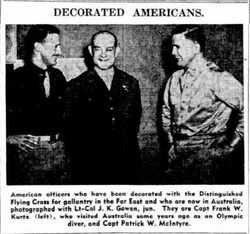
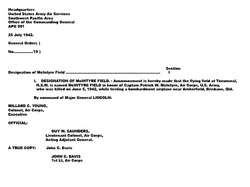
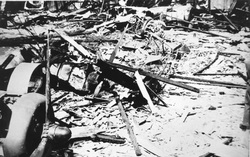
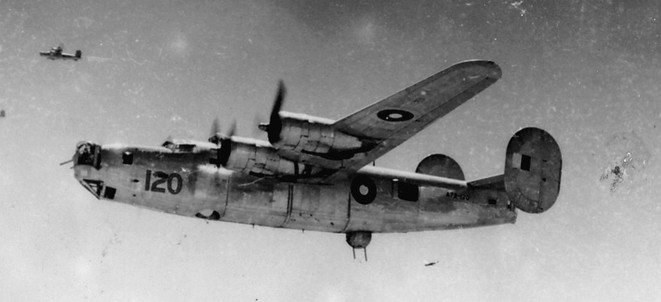
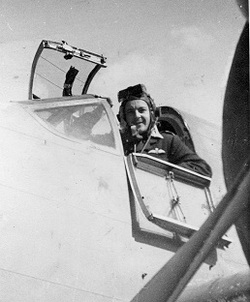
 RSS Feed
RSS Feed
